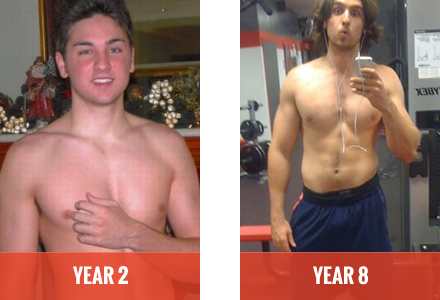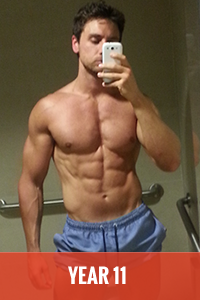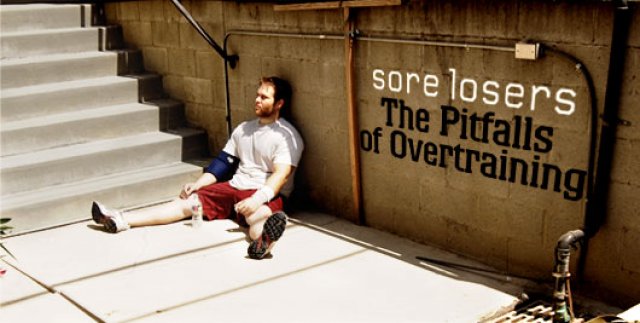There’s a reason why the majority of people that work out regularly don’t have much to show for it, and why so few people ever build truly impressive physiques. And, contrary to popular belief, it’s not (the lack of) steroids–many drug users are just as flabby and weak as the next guy.
The reason why so few people are able to build muscular, strong, lean, healthy bodies is they are doing too many things wrong in and outside of the gym.
Training and eating right isn’t particularly complicated, but there are quite a few moving parts that need to be integrated and coordinated. It’s not as simple as “train hard and eat big.” There aren’t a couple “secrets” to getting big, lean, and strong. There are a collection of principles that must be properly and consistently applied.
In this article, we’re going to talk about the training side of the equation. Specifically, the biggest weightlifting mistakes that I see people make, and why they keep you small, weak, and frustrated.
Let’s get to it.
Table of Contents
Want to listen to more stuff like this? Check out my podcast!
Weightlifting Mistake #1:
Focusing on High-Rep “Burnout” Workouts
If you want to work your ass off for little-to-no results, especially as you move beyond the “newbie phase,” and eventually hit an unbreakable plateau, then you want to emphasize higher rep ranges in your weightlifting.
And by “higher rep ranges,” I’m talking about the widely recommended “hypertrophy” rep ranges of 8 to 10 and 10 to 12 reps per set.
I used to be a dedicated high-repper and one of the biggest lessons I’ve learned in dramatically (and naturally) transforming my physique is just how important heavy lifting is.
You see, for nearly 7 years, I bounced from one high-rep, high-volume magazine workout to another… did all kinds of frequency splits…spent close to 2 hours in the gym every day… wasted hundreds of dollars per month on supplements… and this is what it got me:

As you can imagine, I wasn’t very thrilled.
I was so used to my routine that I just went through the actions every day, but I was certain I just didn’t have the genetics to look good or get really strong, and that even if I did, I thought it would require steroids.
It turns out I was wrong. By changing the focus of my weightlifting to heavy (4 – 6 or 5 – 7 rep range, or 80 – 85% of 1RM) pulling, pushing, and squatting, here’s how my body changed in the 2.5 years that followed the year 8 shot:

I added close to 15 pounds of muscle during this period (which is very impressive considering how long I had been lifting for), increased my strength by 50 to 100% across the board, and greatly improved my overall proportions. (And yes, I also learned how to diet properly along the way!)
The bottom line is working with 80 to 85% of your 1RM (which puts you in the 4 to 6 or 5 to 7 rep ranges) is an incredibly effective way to stimulate both myofibrillar and sarcoplasmic hypertrophy, resulting in big, dense, strong muscles that don’t disappear when your pump subsides or when you get lean.
Trust me on this one–the big, shredded guys that do 15-25 sets per workout, 10-12+ reps per set, with supersets, drop sets, and other fancy rep schemes, can only look like they do because of drugs.
You, as a natural weightlifter, will get nowhere with their routines. It took me years of spinning my wheels to learn this.
Weightlifting Mistake #2:
Doing a Bunch of Isolation Exercises

This mistake is a natural outgrowth of the last, as the high-rep burnout workouts almost always have you doing a bunch of isolation work.
In case you’re not familiar with the term, an isolation exercise is an exercise that mainly involves one muscle group (it isolates it). For instance, a dumbbell front raise is an isolation exercise that targets your anterior (front) deltoid muscle.
The opposite of an isolation exercises is a compound exercise, which is one that involves multiple muscle groups. For example, my favorite compound exercise for shoulders is the Seated Military Press.
So, in my old workouts, probably 70-75% of my reps were isolation exercise reps. and I almost never did compound exercises vital to building a big, strong physique such as the Deadlift, Squat, Bench Press, and Military Press.
Isolation work has a place in a natural weightlifter’s workout routine–I don’t completely shun it like some gurus–but it should never constitute the majority of reps performed in workouts.
[tweet “Isolation work should never be the focus in a natural weightlifter’s workout routine.”]
The bottom line is compound exercises should be the bulk of your workouts, even if you’re an advanced weightlifter.
Weightlifting Mistake #3:
Ascending Pyramid Training

Not only did I used to focus on high-rep workouts, I also followed a standard pyramid protocol that went like this:
Set 1 – light weight: 12-16 reps
Set 2 – light/medium weight: 10-12 reps
Set 3 – medium weight: 8-10 reps
Set 4 – heavy weight: 4-6 reps
This type of protocol sucks because by the time you get to anything remotely heavy, you’re so fatigued from your previous sets that you can barely move the weight and thus can’t sufficiently overload your muscles
When you’ve already exhausted your muscles and then try to load up the plates, you’re going to find that you can’t lift nearly as much as you could if you hadn’t done all the lightweight work. For example, if you can Bench Press 225 pounds for 5 reps when you’re fresh, you’ll be lucky to get more than 5 reps with 185 pounds using an ascending pyramid workout structure.
The real problem here relates to progressive overload, which boils down to progressively increasing tension levels in the muscle fibers over time. That is, adding weight to the bar, progressively lifting heavier and heavier weights over time.
Progressive tension overload is, in my opinion (and the opinion of quite a few experts much smarter than me), the most powerful driver of muscle growth. A simple rule of thumb for us natural weightlifters: if you want to get bigger, you have to get stronger, and ascending pyramid training is horrible for building strength.
[tweet “A rule of thumb for natural weightlifters: if you want to get bigger, you have to get stronger.”]
Yes, muscles can get stronger without getting bigger (thanks to neuromuscular adaptations), but there comes a point where additional strength requires bigger muscle fibers, and progressive overload is the key to making that happen.
When you start your workout with a bunch of high-rep work, you’re causing a lot of fatigue in the muscle cells, but this isn’t a primary driver of muscle growth.
Instead of following an ascending pyramid structure, I recommend you warm up, jump right into your heavy lifting, and move up in weight once you reach the top of the rep range you’re working in.
For example, if you’re training in the 4-6 rep range and get 6 reps on your first set of an exercise, you move up in weight (5 pounds if using dumbbells, 10 pounds if it’s a barbell exercise).
You then work with this new weight, with which you’ll likely get 4 reps on the next set, until you can lift it for 6 reps (this may take one week or three depending on the exercise and how advanced of a lifter you are), after which point you move up, and on it goes.
In this way, you will lift heavier and heavier weights over time, and will be using progressive overload to your advantage.
Weightlifting Mistake #4:
Resting Too Little in Between Sets

Most people are in the gym to move and sweat, so sitting around in between sets seems counter-productive. Thus, they keep rest periods as short as possible or, in some cases, eliminate them altogether with super-sets, drop-sets, “metabolic conditioning” bouts, and other methods of staying in motion.
If their primary goal is to build muscle and strength, however, they’re looking at things incorrectly.
As you now know, building muscle and strength requires heavy lifting, and when you lift heavy weights, you push your muscles to their full contraction capacity. Sufficient recovery time in between sets is what allows you to repeat this process enough to achieve the optimum amount of muscle overload to stimulate and force new growth.
If you’re lifting weights to build muscle and strength, adequate rest in between sets is vital.
[tweet “If you’re lifting weights to build muscle and strength, adequate rest between sets is vital.”]
Basically, the whole point of resting between sets is to prepare your muscles to lift maximum weight in the next set. This isn’t just theory, either—clinical research has correlated intra-set rest times and gains in both strength and muscle size.
For instance, one study conducted by researchers at the Federal University of Parana (Brazil) found that when subjects performed the Bench Press and Squat with 2-minute rest intervals, they were able to perform significantly more repetitions per workout than when rest intervals were shortened in 15-second increments (1:45, 1:30, 1:15, and so forth).
This is significant because total workout volume (the total amount of reps performed each workout) is a major factor in achieving overload and stimulating muscle growth.
Thus, it’s not surprising that this study conducted by researchers at Kennesaw State University found that subjects gained more muscle when training to failure with 2.5-minute rest periods as opposed to 1-minute periods.
Furthermore, an extensive review of weightlifting studies conducted by researchers at State University of Rio de Janeiro found the following:
“In terms of acute responses, a key finding was that when training with loads between 50% and 90% of one repetition maximum, 3-5 minutes’ rest between sets allowed for greater repetitions over multiple sets.
“Furthermore, in terms of chronic adaptations, resting 3-5 minutes between sets produced greater increases in absolute strength, due to higher intensities and volumes of training. Similarly, higher levels of muscular power were demonstrated over multiple sets with 3 or 5 minutes versus 1 minute of rest between sets.”
These findings were echoed by another study conducted by scientists at Eastern Illinois University with resistance trained men:
“The findings of the present study indicate that large squat strength gains can be achieved with a minimum of 2 minutes’ rest between sets, and little additional gains are derived from resting 4 minutes between sets.”
In another paper, the same research team analyzed Bench Press performance with the same subjects and found the following:
“When the training goal is maximal strength development, 3 minutes of rest should be taken between sets to avoid significant declines in repetitions. The ability to sustain repetitions while keeping the intensity constant may result in a higher training volume and consequently greater gains in muscular strength.”
The evidence is clear: when you’re lifting heavy weights and building strength is the goal, 2.5 to 4 minutes of rest in between sets is the way to go.
[tweet “When you’re lifting heavy weights, 2.5 to 4 minutes of rest in between sets is the way to go.”]
It’s worth noting, however, that rest times can be shortened when loads are lightened without negatively impacting performance. If you’re working in the 8 to 10 or 10 to 12 rep range for sets, you can cut your inter-set rest times down to 60 to 90 seconds.
Weightlifting Mistake #5:
Using Improper Form

One of the most painful sights in gyms is the ego lifters spastically throwing around big weights with reckless abandon. I cringe not only out of pity but out of the anticipation of injuries that could strike at any moment.
The sad truth is most people don’t have a clue about proper form on many exercises and this ignorance stunts their gains, causes unnecessary wear and tear on ligaments, tendons, and joints, and opens the door to debilitating injuries (especially as weights get heavy on the shoulders, elbows, knees, and lower back).
Some of these people just don’t know any better, and some are more interested in looking cool than in making real gains. Others were just taught wrong.
While an in-depth discussion of proper form on various articles is beyond the scope of this article, start here:
How to Train Your Chest With Proper Form
How to Train Your Back With Proper Form
How to Train Your Shoulders With Proper Form
How to Train Your Arms With Proper Form
How to Train Your Legs With Proper Form
Weightlifting Mistake #6:
Overtraining

Generally speaking, the harder you work at something, the more likely you are to win at it. Weightlifting is different, though.
Yes, it takes a lot of hard work to build a strong, muscular body, but if you get too zealous in your efforts, it can become counter-productive. Or even destructive (you can lose muscle and strength if you train too much).
You see, your muscles can only take so much of a beating every week before your body falls behind in repair and recovery. Just because you feel like you could add another 30 minutes to your workouts, or another day to your weekly rotation, doesn’t mean you should.
Research has shown that even in resistance-trained, college-aged men, full muscle recovery can take anywhere from 48 to 96 hours depending on how they trained, ate, and slept, as well as other physiological factors like hormones and genetics.
If we look at other recovery-related studies, we see that most people’s muscles take closer to 72 – 96 hours to fully recover from an intense weightlifting session, that older men need more time to recover than young, and that larger muscles need more time to recover than smaller.
Intense weightlifting also places a lot of stress on the nervous system, and research has shown that this fatigue can “accumulate” from workout to workout. If it becomes too great, overtraining symptoms set in, which includes a dramatic reduction in performance, depression, sleep disturbances, and more.
Finding scientific help on the matter of optimal training volume is tough due to the number of variables involved, but something of an answer can be found in a large review conducted by researchers at Goteborg University.
I’ll get straight to the point and quote the research:
“Overall, moderate volumes (~30 to 60 repetitions per session for [Dynamic External Resistance] training) appear to yield the largest responses.”
While advanced lifters seem to be able to stretch this range a bit, it has a lot of anecdotal support and is commonly recommended by educated, experienced weightlifters and bodybuilders. If you look at many of the popular, tried-and-true routines out there, the weekly workout volume generally falls in there somewhere (30 to 60 repetitions performed per major muscle group per 5 to 7 days).
For example, my Bigger Leaner Stronger program has you do 9 to 12 sets of 4 to 6 reps per major muscle group, per week. You move up in weight once you get 6 reps (which usually knocks your next set down to 4 reps), so the workouts range between 45 and 60 high-intensity reps. And people make fantastic strength and size gains on the program.
My program for advanced weightlifters, Beyond Bigger Leaner Stronger, entails doing about 60 to 75 reps per workout, with a combination of very high-intensity, high-intensity, and moderate-intensity work. This workout volume—both the number of reps and the intensities used—has both scientific and anecdotal evidence on its side. It works, period.
What do you think about these weightlifting mistakes? Have anything else to share? Let me know in the comments below!
+ Scientific References
- Goldberg AL, Etlinger JD, Coldspink DF, Jableck C. Mechanism of work-induced hypertrophy of skeletal muscle. Med Sci Sports. 1975;7(4):248-261. doi:10.1249/00005768-197500740-00003
- Wernbom M, Augustsson J, Thomeé R. The influence of frequency, intensity, volume and mode of strength training on whole muscle cross-sectional area in humans. Sport Med. 2007;37(3):225-264. doi:10.2165/00007256-200737030-00004
- Mujika I, Padilla S. Scientific bases for precompetition tapering strategies. Med Sci Sports Exerc. 2003;35(7):1182-1187. doi:10.1249/01.MSS.0000074448.73931.11
- Bishop PA, Jones E, Woods AK. Recovery from training: A brief review. J Strength Cond Res. 2008;22(3):1015-1024. doi:10.1519/JSC.0b013e31816eb518
- McLester JR, Bishop PA, Smith J, et al. A series of studies--a practical protocol for testing muscular endurance recovery. J strength Cond Res. 2003;17(2):259-273. http://www.ncbi.nlm.nih.gov/pubmed/12741861. Accessed October 24, 2019.
- Willardson JM, Burkett LN. The effect of rest interval length on bench press performance with heavy vs. light loads. J strength Cond Res. 2006;20(2):396-399. doi:10.1519/R-17735.1
- Willardson JM, Burkett LN. The effect of different rest intervals between sets on volume components and strength gains. J strength Cond Res. 2008;22(1):146-152. doi:10.1519/JSC.0b013e31815f912d
- de Salles BF, Simão R, Miranda F, Novaes J da S, Lemos A, Willardson JM. Rest interval between sets in strength training. Sports Med. 2009;39(9):765-777. doi:10.2165/11315230-000000000-00000
- Buresh R, Berg K, French J. The effect of resistive exercise rest interval on hormonal response, strength, and hypertrophy with training. J strength Cond Res. 2009;23(1):62-71. doi:10.1519/JSC.0b013e318185f14a
- Souza-Junior TP, Willardson JM, Bloomer R, et al. Strength and hypertrophy responses to constant and decreasing rest intervals in trained men using creatine supplementation. J Int Soc Sports Nutr. 2011;8. doi:10.1186/1550-2783-8-17
- Hakkinen K, Pakarinen A, Alen M, Kauhanen H, Komi P V. Neuromuscular and hormonal adaptations in athletes to strength training in two years. J Appl Physiol. 1988;65(6):2406-2412. doi:10.1152/jappl.1988.65.6.2406











